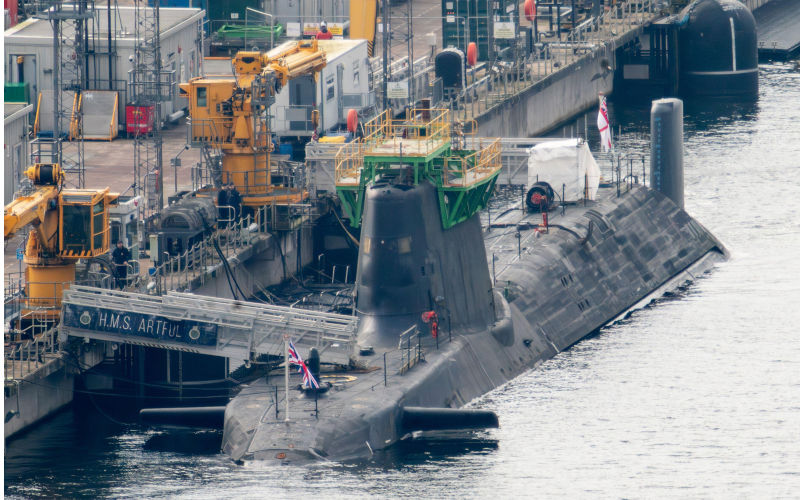The British experience with nuclear-powered submarines: Lessons for Australia
August 11, 2025
My new report prepared for Friends of the Earth Australia demonstrates that the development of a nuclear-powered, conventionally-armed nuclear submarine fleet entails multiple public health risks and would inevitably suffer from delays and cost-blowouts.
The British experience with SSNs reveals a litany of problems and it can confidently be predicted that problems will beset the AUKUS submarine program ‒ the joint development of nuclear-powered submarines by the UK, the US and Australia.
Operational risks of SSN deployment include radiological pollution of marine and coastal environments and wildlife; risks of radioactivity doses to coastal populations; and the serious risk of dangerous collisions between civilian vessels and SSNs, especially in the approaches to busy naval and civilian sea ways and fishing grounds.
Ominously, the problems seem to be worsening. In May 2025, it was revealed that the number of “incidents” at the Faslane naval base has been on the rise in recent years. The UK Ministry of Defence acknowledged that 12 incidents since 2023 had “actual or high potential for radioactive release to the environment”, but refused to say what actually happened in any of the incidents, or exactly when they occurred.
Navy Lookout reported on a major fire in October 2024 at the BAE System’s yard where nuclear submarines are built. After initial claims of no damage or delay to construction of Astute class attack subs, damage was later confirmed and delays are certain.
Meanwhile, radioactive air emissions have been increasing year-on-year at Coulport, a nuclear submarine base in Scotland. Emissions of radioactive tritiated water vapour doubled between 2018 and 2023.
First and second generation submarine reactors
Case studies of the first generation of British SSNs reveal an inconsistent performance history of reactor cores. The reactors were characterised by a marked tendency to develop “serious cracking in the primary cooling circuits” leading to leaks of cooling water. In some cases, these problems were recurrent despite repair and were the cause of premature retirement of some boats. The second generation of British SSNs had to undergo extensive maintenance periods and expensive refit of new reactor cores.
Historically, testing of submarine reactor cores by the Naval Reactor Test Establishment provided vital information. For example, the seven-year-long maintenance outage of HMS Vanguard from 2015-22 followed reports of observed reactor malfunctions from the NRTE. In 2009, the NRTE reported that malfunctions posed a “significant risk to life in close proximity and a public safety hazard out to 1.5km from the submarine”.
In 2015, in the aftermath of NRTE reports of reactor and nuclear fuel malfunction, the UK Government and the Ministry of Defence decided to close down the NRTE and to abandon empirical “lead” research on naval reactors in favour of computer modelling. This also applies to AUKUS SSNs, which will be the first UK-designed and built nuclear-powered submarines to be run without the benefit of the NRTE input.
Delays and cost blowouts
In November 2009, the UK House of Commons Defence Select Committee found that delays due to technical and program issues meant the Astute class SSN program was 57 months late and 53% over-budget.
By March 2021, Astute SSNs were delivered between three to five years behind the original schedule. This necessitated the extension in service of HMS Trenchant, Talent and Triumph with the attendant costs of keeping ageing boats running.
There are now growing indications from sources close to the UK Government and Ministry of Defence that the AUKUS successor to the Astute class submarines may be delayed due to financial and technical issues. “It’s early days … but the first boat is unlikely to arrive before the mid-2040s,” Navy Lookout reported in 2023.
Decommissioning and dismantling nuclear-powered submarines
The UK experience is that the decommissioning, defuelling and scrapping of nuclear submarines is fraught with technical problems and delays arising from those problems. It is also clear that these issues give rise to ever-increasing costs.
In 2019, the National Audit Office published its report of an investigation into submarine defuelling and dismantling. The investigation took place between 2017 and 2019. The NAO reported that despite the Ministry of Defence’s 20-year-old commitment to dispose of the 20 submarines it had decommissioned since 1980, none had been completely dismantled by 2019 and that the Ministry stored twice as many nuclear submarines as it operated.
The long-term management, storage and disposal of radioactive waste streams from nuclear submarines remains unsolved in the UK after many decades. And radioactive waste management remains unsolved in Australia, which does not even have a national repository for low-level waste, let alone a disposal option for long-lived intermediate-level waste and high-level waste.
Sinking of civilian vessels, collisions, near misses, groundings
Between 1982 and 2015, UK civilian sources collated a dossier of information on 170 “interactions” between civilian vessels and nuclear submarines including net “snaggings”, collisions, near misses and at least 30 suspicious unexplained sinkings in UK waters. These incidents have led to loss of life, total loss of vessels and loss of fishing gear. Despite not firing a shot in anger, UK nuclear submarines have been responsible for the death of a number of UK citizens as a result of such interactions.
Despite the best attempts of both civilian and Defence authorities, the secrecy surrounding nuclear submarine operations makes risk avoidance that much more complex, with notification of nuclear submarine movements not publicised and the details of patrol and training strategies not divulged to judicial or government agency inquiries.
Another problem concerns radioactive discharges from submarine bases. One study demonstrated that a coastal population living approximately 32km downstream of a submarine base received a higher dietary dose of man-made radioactivity from locally grown food stuffs than did a population living next to a civilian nuclear power station.
The report, “The British experience with nuclear-powered submarines: lessons for Australia”, is online.
The views expressed in this article may or may not reflect those of Pearls and Irritations.
